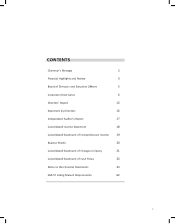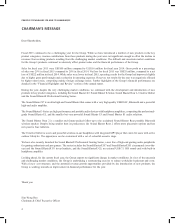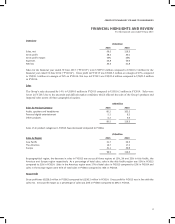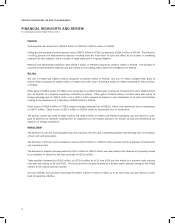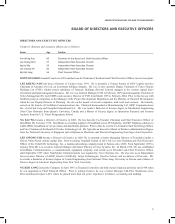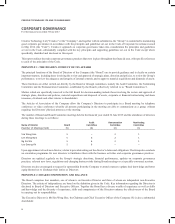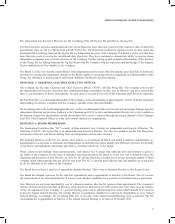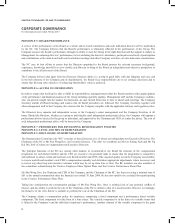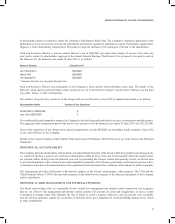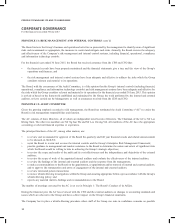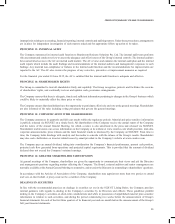Creative 2015 Annual Report Download - page 8
Download and view the complete annual report
Please find page 8 of the 2015 Creative annual report below. You can navigate through the pages in the report by either clicking on the pages listed below, or by using the keyword search tool below to find specific information within the annual report.
8
CREATIVE TECHNOLOGY LTD AND ITS SUBSIDIARIES
PRINCIPLE 5: BOARD PERFORMANCE
A review of the performance of the Board as a whole and its board committees and each individual director will be undertaken
by the NC. The Company believes that the Board’s performance is ultimately reected in the performance of the Group. The
Company assesses the Board’s performance through its ability to steer the Group in the right direction and the support it renders to
Management. In evaluating directors’ performance, factors including the directors’ attendance, participation and level of participation
and contributions at the main board and board committee meetings and other Company activities, are also taken into consideration.
The NC uses its best efforts to ensure that the Directors appointed to the Board possess the relevant necessary background,
experience, knowledge and skills so as to enable each Director to bring to the Board an independent and objective perspective to
contribute to the effectiveness of the Board.
The Company believes that apart from the Directors’ duciary duties (i.e. acting in good faith, with due diligence and care, and
in the best interests of the Company and its shareholders), the Board’s key responsibilities are to set strategic directions and to
ensure that the long term objective of enhancing shareholders’ value is achieved.
PRINCIPLE 6: ACCESS TO INFORMATION
In order to ensure that the Board is able to fulll its responsibilities, management provides the Board members with regular updates
of the performance and nancial position of the Group including quarterly updates. Management staff and the Company’s auditors,
who can provide insight into the matters for discussion, are also invited from time to time to attend such meetings. The Company
Secretary attends all Board meetings and ensures that all Board procedures are followed. The Company Secretary, together with
other management staff of the Company, also ensures that the Company complies with the applicable statutory and regulatory rules.
The Directors have separate and independent access to the Company’s senior management and the Company Secretary at all
times. Should the Directors, whether as a group or individually, need independent professional advice, the Company will appoint a
professional advisor selected by the group or individual, and approved by the Chairman and CEO, to render the advice. The cost of
such independent professional advice will be borne by the Company.
PRINCIPLE 7: PROCEDURES FOR DEVELOPING REMUNERATION POLICIES
PRINCIPLE 8: LEVEL AND MIX OF REMUNERATION
PRINCIPLE 9: DISCLOSURE ON REMUNERATION
The Remuneration Committee (the “RC”) consists of three Directors, two of whom are independent non-Executive Directors. The
Chairman of the RC is Mr Sim Wong Hoo, an Executive Director. The other two members are Mr Lee Kheng Nam and Mr Ng
Kai Wa, both of whom are independent non-Executive Directors.
The principal functions of the RC are, among other matters, to recommend to the Board the structure of the compensation
programme for each Board member and the CEO (or executive of equivalent rank) to ensure that the programme is competitive
and sufcient to attract, retain and motivate each Board member and CEO of the required quality to run the Company successfully;
to review each Board member’s and CEO’s compensation annually and determine appropriate adjustments where necessary; and
to review any other long term incentive schemes which may be set up from time to time. The RC members are also members of
the committees administering the Creative Employee Share Option Plans and the Creative Performance Share Plan.
Mr Sim Wong Hoo, the Chairman and CEO of the Company, and the Chairman of the RC, has been receiving a nominal sum of
S$1 as his annual remuneration since the nancial year ended 30 June 2008. He has also opted to be excluded from participating
in the Creative Performance Share Plan.
Taking into consideration the remuneration package of Mr Sim Wong Hoo, there is minimal risk of any potential conict of
interest, and his ability to perform the role of the Chairman of the RC is similar to that of a non-Executive Director. Accordingly,
the Board is of the view that he is suitable to perform the role of the Chairman of the RC.
The Company adopts a remuneration policy for employees comprising a xed component and a performance based variable
component. The xed component is in the form of a base salary. The variable component is in the form of a variable bonus that
is linked to the Company’s and the individual employee’s performance. Another element of the variable component is the grant
CORPORATE GOVERNANCE
For the nancial year ended 30 June 2015

